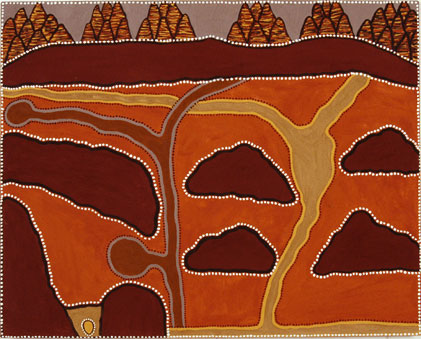
Barry Malgil, Lumugun, Wuniba & Purnululu, 2010.
Natural ochre and earth pigments on canvas, 80 x 100cm.
Courtesy: the artist and Warmun Art Centre
‘This truly interdisciplinary approach is a step forward towards a constructive response to the pressing global problem of climate change that includes indigenous voices and agency.’ (The Cross Art Projects)
Wet Time, Cold Time, and Hot Time: these are the seasons described by the title of the exhibition Jadagen Warnkan Barnden which brings together an exceptional and informative collection of ochre works by Senior Gija artists of the Warmun Art Centre.
In March 2011, nearly 90 per cent of artwork at the Warmun Art Centre was lost after the extreme flooding of Turkey Creek following weeks of heavy rain. Cars and houses were washed away. Some artists lost everything. Over 400 paintings have since been restored in Melbourne and returned to the Warmun community only months ago. This is just one of a number of cases concerning environmental disturbance recalled by Gija artists in Jadagen Warnkan Barnden. The exhibition provides an important platform for Indigenous artists to publicly engage in global discussions surrounding climate change – an issue by which local Indigenous communities find themselves increasingly affected.
Rather than following the calendar months, Gija seasons are directly linked to indicators within the immediate environment in the north of the Kimberley region at the top of Western Australia. Over time, the Gija community has observed extreme weather events and other anomalies such as the ‘”big wet” of 2011 that have rendered these seasonal indicators less and less reliable. These continue to be weakened by the stresses placed upon the land by contemporary society. Paintings by Gordon Barney, Churchill Cann, Betty Carrington, Mabel Juli, Nancy Nodea, Lena Nyadbi, Rusty Peters, Shirley Purdie and Mary Thomas explore these impacts, demonstrating an acute understanding of their surrounding environment. The depth of their knowledge provides viewers with an insight into how the landscape is adapting to these changes.
The connection that Gija artists have to their country is typically represented by their use of natural ochres, rendering their work literally inseparable form the land. The land forms an integral part of Gija identity and this is reflected in their art which in 2013 has been widely acknowledged both at home and away. In June the Musée du Quai Branly in Paris unveiled Lena Nyadbi’s monumental rooftop commission of Dayiwul Lirlmim, now her second artwork to be integrated into the museum’s cutting edge architecture. This was supported by an exhibition of Gija work at the Australian Embassy in Paris, Gija Manambarram Jimerawoon (Gija Senior Law People Forever). On top of this, Lena was recently nominated for Visual Artist of the Year at the Deadlys while last month Mabel Juli was awarded the Kate Challis RAKA Award for 2013 and Churchill Cann won the Western Australian Indigenous Art Award.
Jadagen Warnkan Barnden is accompanied by a publication including contributions from Alana Hunt, Frances Kofod and Sonia Leonard of the Indigenous Perspectives of Climate Change project team. Their research interrogates the question of how traditional knowledge can be integrated with Western science to combat the challenges of climate change, and establish greater resilience for the future. The exhibition together with the publication aims to produce a meaningful interdisciplinary dialogue across the fields of art, climate change and linguistics, giving voice to expert Indigenous perspectives on the impact of climate change.
SOURCES:
The Cross Art Projects, Jadagen Warnkan Barnden — Changing Climate in Gija Country,
Available from: http://www.crossart.com.au/index.php/jadagen-warnkan-barnden-changing-climate-in-gija-country.html (Accessed 16/09/13)
O’Sullivan, Jane ‘Warmun Art Centre “Almost Destroyed” in Flood’ (March 2011)
Available from: http://www.artcollector.net.au/WarmunArtCentrealmostdestroyedinflood (Accessed 16/09/13)
Collins, Ben & Hilary Smale, ‘Flood damaged Warmun art returns home to the East Kimberley’, ABC Kimberley, (14 June, 2013)
Available from: http://www.abc.net.au/local/audio/2013/06/14/3782223.htm (Accessed 16/09/13)